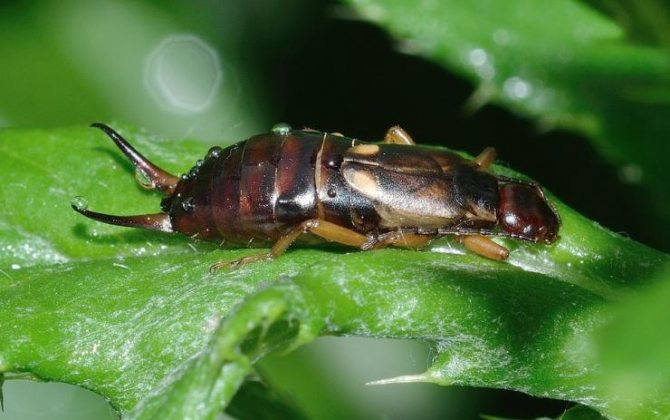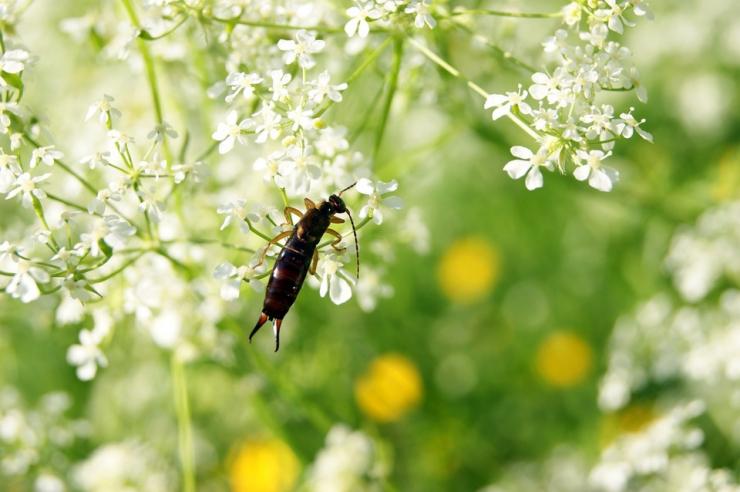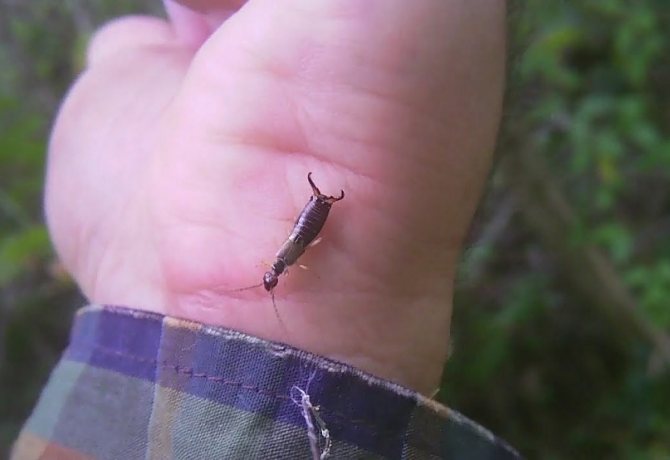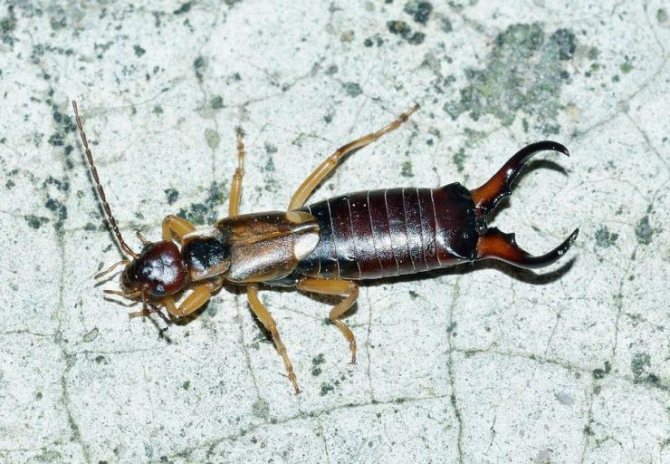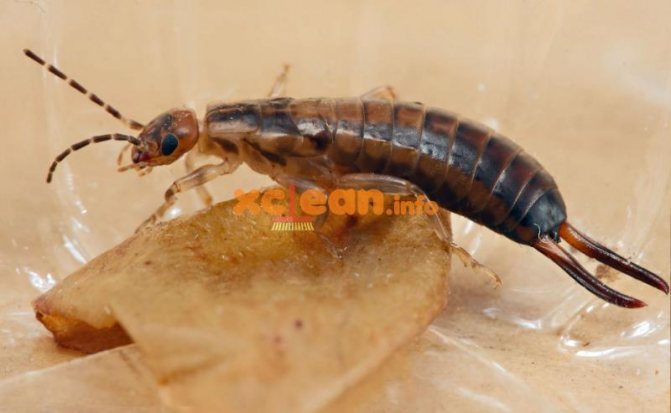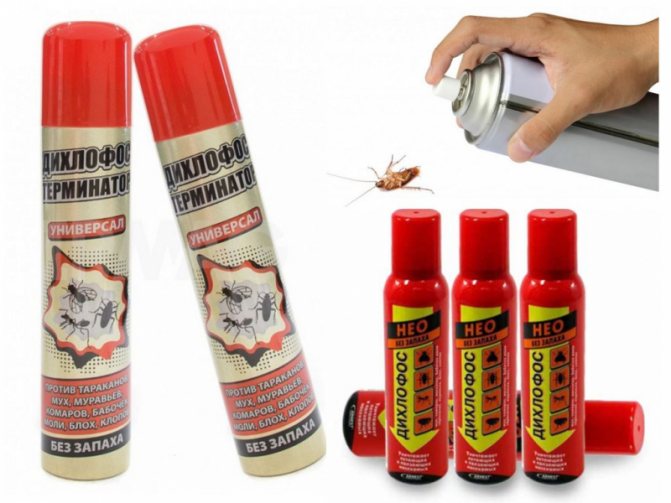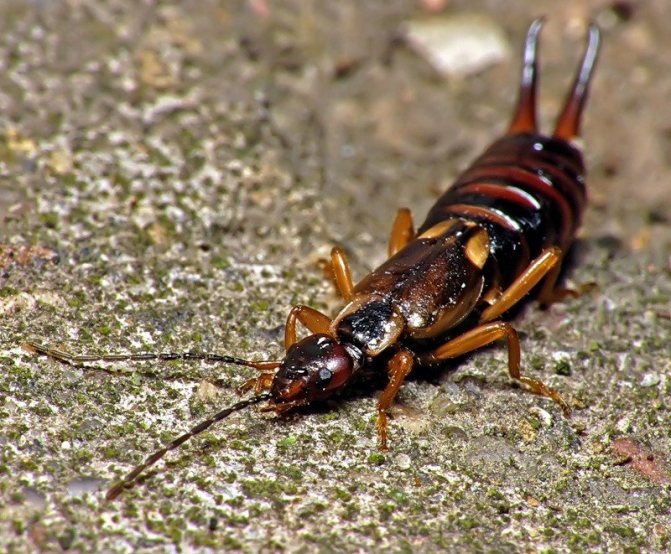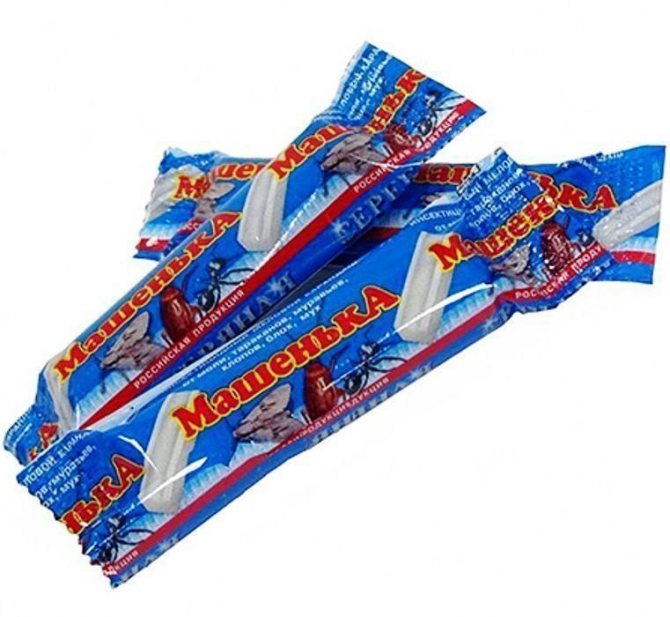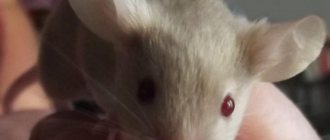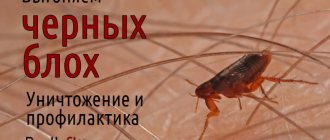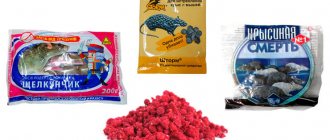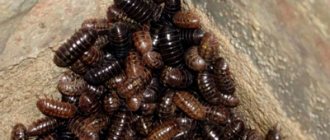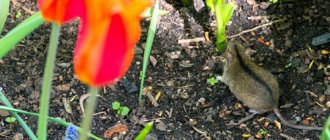These formidable-looking insects can appear both in a private house and in a city apartment. Earwigs, otherwise called two-tails, are of the arthropod type. The insect is 2-3 centimeters long and has rather large antennae on its head. The back of the body is equipped with a kind of sting. It can be in the form of two thin threads or powerful claws. The bite is quite noticeable, but not dangerous, since the two-tails are not poisonous.
Earwigs are a danger to parasitic insects. In the house where they live, there will be no cockroaches, bedbugs and other pests. Despite these advantages, they are not desirable "neighbors" for a person, and their distribution in a residential apartment or house is unacceptable.
- The bite, although not fatal, is very painful. The site of the lesion may be red, swollen, itchy. An allergic reaction is not excluded. They are especially dangerous for young children.
- Like other insects, they are carriers of pathogenic bacteria and viral infections. They are brought in both mechanically and through the blood after a bite.
- They eat plants and vegetables, so they can damage both potted flowers and the vegetable garden.
The well-known myth about earwigs, which crawl into the ear at night and gnaw through the eardrum, has no real confirmation. Nevertheless, the very fact that an insect crawls on the bed while sleeping is disgusting.
Description of two-tailed and earwigs
Two-tailed insects (Diplura) are wingless arthropods recently bred into a separate independent class, which includes such subspecies as Projapygidae, Campodeidae, Japygidae. Distributed mainly in the tropical and subtropical parts of the planet. In Russia, there are 20-30 species of Campodeidae, in the southern part of the country Japygidae. The average life span of a two-tailed insect is 12 months.
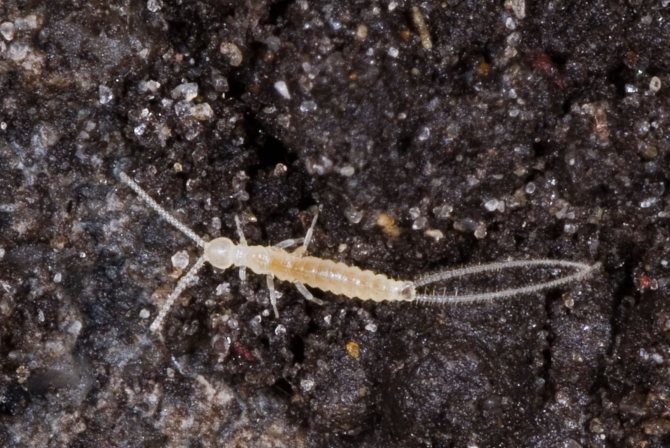
Two-tailed insects are small in size.
Appearance: body length 5-7 mm (specimens 50 mm long are found in the class), 6 pairs of legs, absence of eyes, elongated body, rounded head with antennae, extreme appendages of the last segment of the abdomen are bifurcated, pincer-shaped, or elongated, have the ability to rapid recovery, the oral cavity is hidden inside the head, light color.
They choose a habitat with high humidity: rotten trees, forest litter, damp soil, large anthills, plant debris, greenhouses, compost pits.
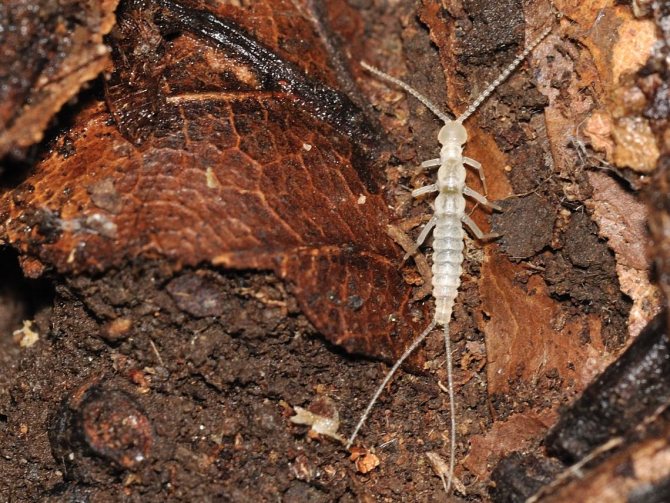

Their body length is 2-5 mm. There are also larger individuals, the body length of which is 50 mm.
Food: leftovers from other animals, insects, plant waste, food debris, fruits, vegetables, shoots and leaves of plants.
Reproduction: the female lays eggs in the soil. Fertilization takes place by getting the spermatophore into the female's genital opening. Spermatophores are very tenacious, they can stand on a thin but stable stalk for up to two days, waiting for a passing female. Cubs hatched from eggs differ from adult two-tails only in their smaller size and the absence of genitals.
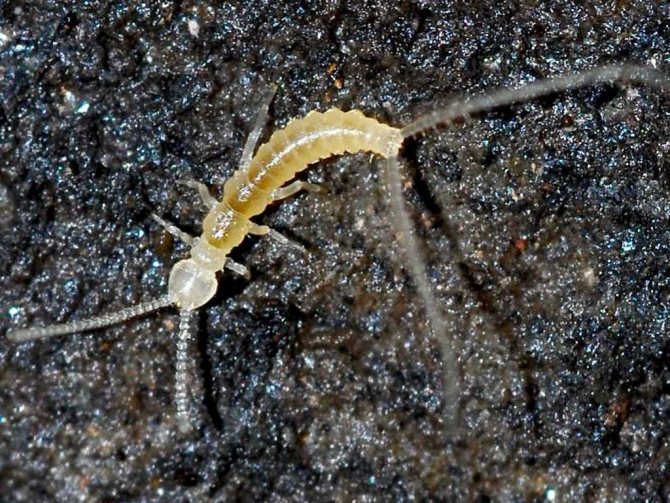

They easily enter the house through cracks, open doors and windows.
Common earwig (Dermaptera) is an insect from the order of leathery-winged animals. There are 1200 species, distributed on almost all continents.
It is interesting! The name of the earwig appeared according to one opinion from the legend that an insect through the ear can enter the brain and destroy it, according to another opinion, the name comes from the word ear-wing (English). The wing shape of the insect is similar to the auricle.
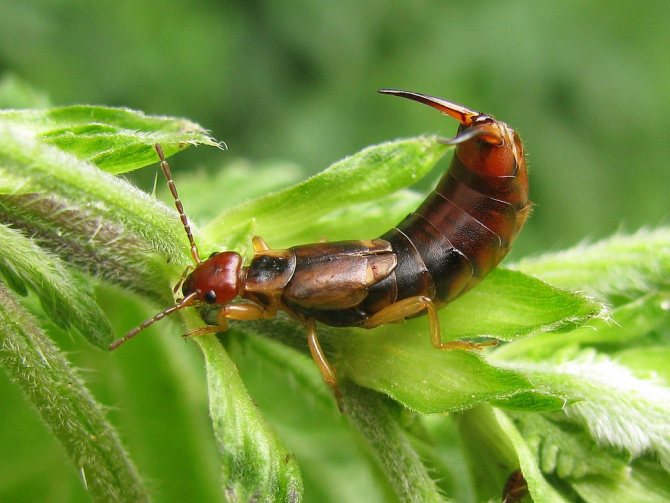

Earwigs, like all household insects, spread infection and worsen people's lives.
Appearance: flexible, curved body, consisting of 10 segments and a dense chitinous cover. Size: 10-16 mm. The color is brown with a brown or resin sheen. The elongated articulated body ends with pincer-shaped cerci. Three pairs of yellow legs. Eyes are missing. Long, multi-segmented whiskers that replace the organs of touch. The mouth gnawing opening protrudes forward. Special Feature: Leathery wings. The anterior transverse ones are compact in size, the posterior ones are fan-shaped, covering the body to the middle of the abdomen. The earwig does not fly. With the help of her wings, she can sometimes make long jumps-flights.
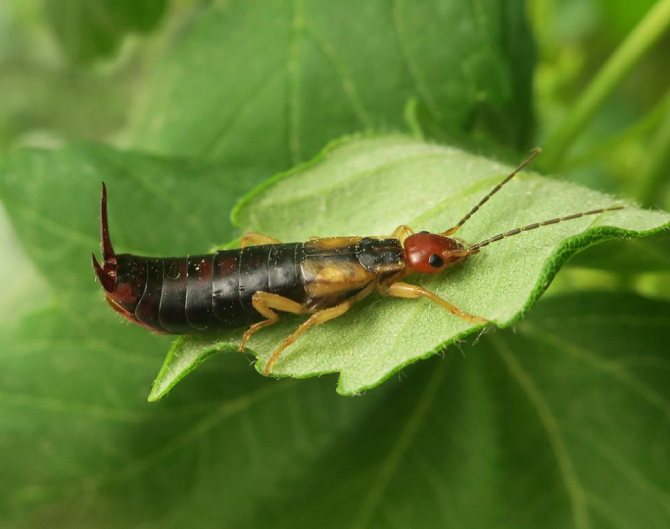

It is difficult to deal with them - they hide well in the daytime.
Habitat: compost pits, heaps of natural debris, utility rooms with high humidity, old trees, a bathhouse, an outdoor shower, a flower bed.
Food: other insects, rotting crops, food leftovers, leaves of garden and garden plants in the country.
Reproduction: incomplete transformation. Mating is characterized by a duration of 6-8 hours. The female climbs and lays eggs in a specially dug hole in the ground. It helps the larvae to hatch by gnawing holes in the eggs, then licks and warms with its warmth.
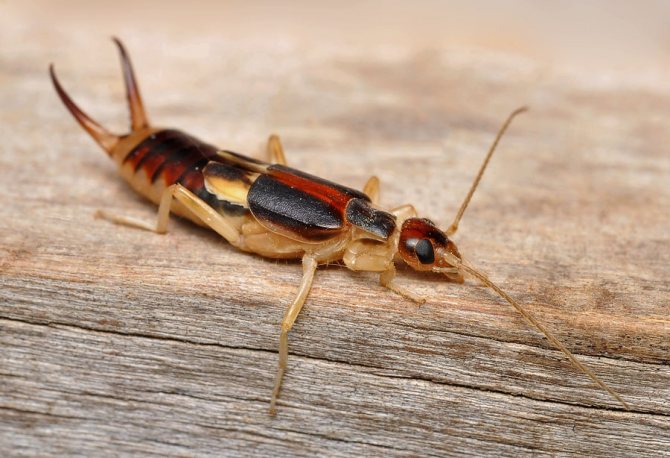

Living in a greenhouse or in a greenhouse in large numbers, these two-tailed creatures cause a lot of problems for gardeners.
Interesting! It is especially noteworthy that the caring female does not abandon the larvae until they turn into adult insects.
Other names: European earwig, tick (Forficula auricularia), pincher, two-tailed.
Insects are similar in sting shape, food type and lifestyle. These predators go hunting at night, during the day they hide in shaded, humid places.
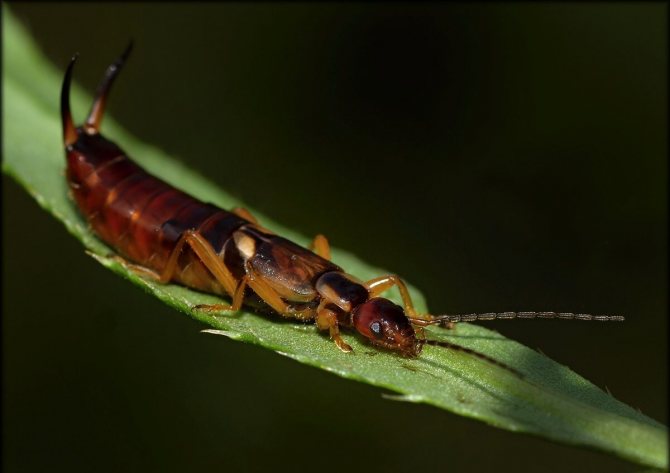

When a person meets a two-tailed, then he immediately associates with painful bites.
Why are two-tails dangerous to humans, are they poisonous or not?
Due to the frightening appearance of the insect, various myths have arisen that the earwig can cause serious harm to human health. According to one of the widespread versions, the two-tailed bird makes its way into the human body through the ear and eats his brain. This is a misconception, like the myth of the poison present on the growths of an insect.
Neighborhood with them does not bode well for a person, since two-tails are carriers of infections. Earwigs cannot bite a person, but they can damage the skin if they grab it with their "pinchers". This causes irritation and, in severe cases, allergies. After the bite, you must:
- Rinse the wound with running water. At the ends of the pincers, tissues of other creatures that the fork-tailed eats could have remained.
- Treat the bite site with a disinfectant: alcohol, hydrogen peroxide, and other available means.
- Take an antihistamine in case of allergies.
With an allergic reaction, watery blisters, burning, itching and deterioration of well-being occur. In this case, you need to visit a doctor.
The pest can cause significant damage to plants and furniture in the home. In the wooden frames of interior items, they make themselves "minks" for wintering and breeding, and garden seedlings and houseplants are one of the types of food for these parasites.
The difference between a two-tail and an earwig
- Insects belong to different families.
- Body color and size.
- Earwigs have wings.
Two-tails are unpleasant to humans for their appearance. Various infections are carried on the legs.They do not threaten a person's life, but an adult pincher can bite noticeably without deeply piercing the skin with pincers.
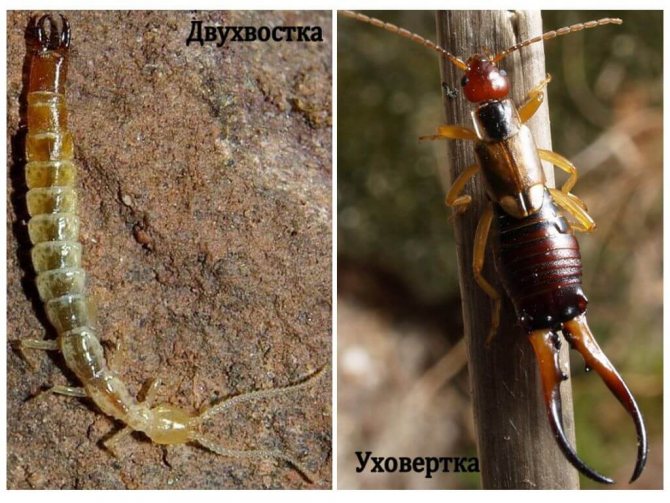

The two-tails are much smaller than earwigs, namely from 2 to 5 mm in length, in the most rare cases up to 5 cm.
Attention! The venom injected with the bite is not poisonous. But allergies are possible: a painful blister appears at the site of the bite. Seek medical attention!
Small amounts of two-tails are beneficial. For example, they destroy aphids in the garden. But due to rapid reproduction, they begin to spoil all planted crops.


According to modern concepts, the first two-tails arose in the Late Carboniferous period.
General sanitation
As already noted, earwigs, in fact, like woodlice, prefer moist places rich in decaying organic debris. Therefore, order and cleanliness in the living quarters and timely repair of plumbing, sewerage, drainage systems, as well as the elimination of atmospheric dampness around the outer perimeter of the house, will greatly help in getting rid of earwigs. But if the foundation is damp, cracked, the wood of the walls is rotting and everything is overgrown with grass, then the traps will constantly be filled with earwigs, and the seedlings will still die, since nothing will hold back such massive attacks of insects, even the most active chemistry.
How two-tails get into housing
- There is high humidity in the room (Reasons: the room is poorly heated, there was a flood, poor ventilation).
- Dampness after leaks, accumulation of moisture when ventilation is not working.
- The presence of cracks in the floor and foundation.
- Unlocked front doors.
- Littering with old unnecessary things.
- Repair (penetration through the riser, basement).
- Move out of the forest and countryside on clothes and animal hair.
- Open windows, not covered with mosquito nets.
- Low-quality fruits and vegetables brought into the house.
- Insects are attracted by the bright light at the entrance to the house.


Two-tails, or fork-tails (Latin Diplura) (not to be confused with earwigs) are a detachment of six-legged cryopods.
What do earwigs eat?
It feeds mainly on rotten or bitten by other insects and pecked fruits. She cannot always bite through the peel, so she chooses flawed fruit.
Vegetables are also not ignored, they can damage the harvest of tomatoes, cabbage, peas
This pest is omnivorous, and some of its taste preferences are beneficial to gardeners - the earwig feeds on aphids and spider mites, but it does a lot of harm itself. It is better if it is not on the site, and you can fight aphids in other ways.
Beekeepers should be especially attentive to the appearance of a dvuhvostka on the site. The earwig loves honey, eats beekeeping products with pleasure.
In dry summers, flower cultures also suffer from two-tails. Of the fruits, the insect prefers peaches, apricots, black currants. It can be seen in bunches of grapes.
Among the numerous pests of tomato plantings, an earwig (two-tailed) is often found. The name of this insect says little, but everyone knows how it looks, more often the earwig is called a two-tailed earwig. An earwig can often be found in private houses, baths, greenhouses and other buildings.
The insect belongs to the order of leather-winged animals, it is rather large in size from 18 to 20 mm. The earwig feeds on flowers, leaves, fruits and other parts of plants, which can harm cultivated plants and vegetables, and in particular tomatoes. In the daytime, an earwig is rarely seen, as two-tailed beasts are nocturnal. During the day, they hide in dark and damp places.
No summer resident who has put so much time and effort into growing tomatoes and caring for them will not tolerate the encroachment of pests on their crops.Therefore, when insects appear on tomato plantings, you need to get rid of them as soon as possible. Most often, gardeners prefer to fight the earwig with folk remedies, and there are many of them in the arsenal.
How to get rid of an earwig
- Setting traps. Food is not a good bait for pests, but the ability to climb into a dark and damp place. Therefore, in order to quickly remove pests from the greenhouse with tomatoes, you need to spread wet rags around the seedlings. And when the two-tails climb into them, remove the rags and pour boiling water over them.
- Scare away the pest. Not all gardeners want to destroy pests; many use various deterrent drugs. You can fight two-tails with chalk and paste against earwigs, they have a special smell that makes pests leave the greenhouse or apartment. Others arrange glasses of basil to get rid of pests, it is believed that its spicy aroma repels the two-tails.
- Seedling isolation. This method is based on the fact that seedlings in boxes are placed so that the two-tails cannot reach them. For this, it is better to use glass jars, since if you put on wood and other materials, then earwigs will climb into boxes along them.
- Chemicals. You can fight two-tails using insecticides. To quickly get rid of insects, you need to spray the seedlings with Iskra or Inta-vir. You can fight with other similar drugs.
- Scare off odorous plants. Almost all insects and small animals do not like the smell of wormwood and tansy. Therefore, in order to scare away insects, you can spread these herbs around the plants or prepare an infusion of them with the addition of laundry soap and process the seedlings.
Prevention measures
In order not only to get rid of the two-tails, but also to prevent the appearance of insects on your site, and tomatoes, you need to adhere to a few simple rules.
- To prevent the greenhouse from settling in two-tails, you need to ventilate it regularly. Excessive moisture attracts these insects. In addition, you do not need to leave heaps of grass there, under which moisture accumulates, and therefore insects.
- Observe the watering regime, that is, do not flood the plants. Watering is best done in the morning, so that the top layer dries up by night.
- Loosening. Regular loosening will not only contribute to the saturation of the soil with oxygen, but also prevent it from waterlogging, which means the likelihood of earwigs appearing will decrease. In addition, you need to try to prevent significant weed growth.
- Timely remove garbage and plant residues from the garden and do not leave them for the winter.
- Follow the recommended seating pattern.
If all preventive measures are followed, the appearance of a two-tail on the site becomes unlikely. And if they did appear, then you can get rid of them with folk or chemical means.
What are the dvuhvostki afraid of the best means inside a dwelling
The name of this insect is almost synonymous with such living organisms that bring destruction and trouble, like termites or mice, but a tiny earwig with a terrible legend is capable of only a fraction of the problems that many of us attribute to it.
The story tells that earwigs got their name from their addiction to piercing people's ears and eating the brain. In fact, earwigs are mostly peaceful creatures that feast on decaying plants and the corpses of large living organisms, although in some cases their massive attacks on delicate stems of seedlings, which are grown on windowsills by fanatical gardeners, are possible.
Below we offer several working methods that will help not only scare away the two-tailed from their home, but also significantly thin out their population.
Traps
Like most insects, earwigs can't say no to sweets.None of these insects can ignore a container filled with molasses, honey, or sugar syrup. Filling a glass jar with this sweetness and closing it with a small hole in a plastic lid is a great way to catch earwigs.
Wet newspapers are also an excellent means of stopping and capturing earwigs. Place the soaked newspapers overnight around the flower pots or seedling trays on your windowsills, and in the morning they will accumulate any earwigs that have tried to penetrate the plants.
In addition, you can purchase special adhesive tape for flies and use it to lay the perimeter of the window sill at the approaches to the plants. When trying to crawl through such an obstacle, earwigs will stick tightly and will not be able to move on to their goal.


Prevention of future invasions
Any effective way of dealing with an earwig should start with preventing it from entering the living area. Inside the house, they do not get divorced, do not even try, but come from their hiding places in search of a better habitat.
- Make sure all window guards are free of holes. This is especially true for situations where the lower level of the window is close to the ground.
- Seal all door frame sills and window frames.
- Close all cracks and holes in the foundation. The same applies to floorboards.
- The water supply and sewerage system of the living quarters should not allow leaks and condensation of moisture.
- The foundation of the house must be free of vegetation and additional moisture from the outside. It must be remembered that dryness is the main enemy of earwigs, which will force her to keep away from home.
Only in the case of massive occupation of the residential area of the premises is it worth seeking professional help from specialists from the sanitary and epidemiological services.
In this case, it is worth paying attention not to the insects themselves, but to the reasons for their appearance, since its exclusion will be effective. If the lower crown of the wooden wall of the house continues to rot in the thickets of weeds or is covered with earth - not a single chemical agent will help from earwigs - I will be removed and replaced by the following
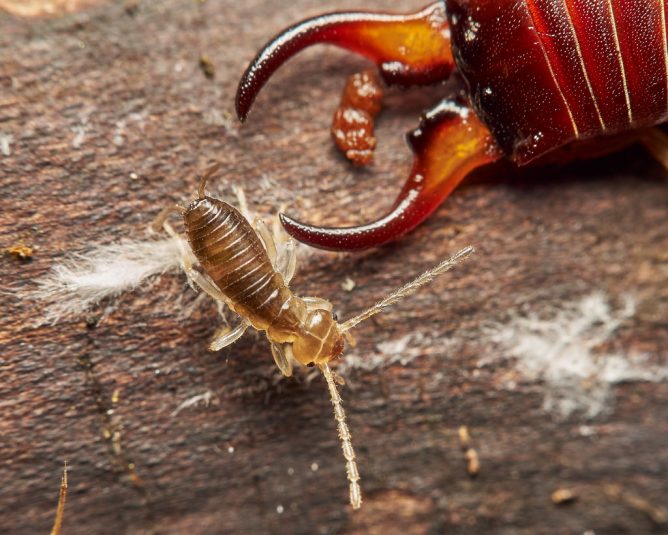

How to poison earwigs in your garden
Earwigs can damage young cultivated plants and other vegetation useful to humans. In addition to attacking young seedlings, soft fruits such as apricots, blackberries, raspberries, stone fruits and strawberries become an attractive diet for insects. They also love flowers and prefer dahlias, marigolds and zinnias. Mature ornamental plants are not included in the earwig menu, so there is no need to worry about their condition.
But there is good news as well. Earwigs are greedy and efficient predators of other plant pests such as aphids and some species of mites. Therefore, before taking on their destruction, you should think carefully and evaluate the power of harm from both.
Below are the main ways to get rid of earwigs in the external environment.
How to get rid of parasites in an apartment
In multi-storey buildings, they are most often found on the first floors: humidity and the proximity of the basement act.
- Clean up order, remove dirty clothes, accumulations of unnecessary things, cleaning rags, etc.
- Ventilate the apartment thoroughly.
- Check the work of plumbing and ventilation systems.
- Eliminate all problems and leaks.
- Perform a general cleaning.
- Pay attention to the storage of food, the presence of unused food residues and accumulations of debris.
- To remove parasites, carefully treat the places where insects accumulate, crevices in the floor, hard-to-reach places in the bathroom and in the kitchen.
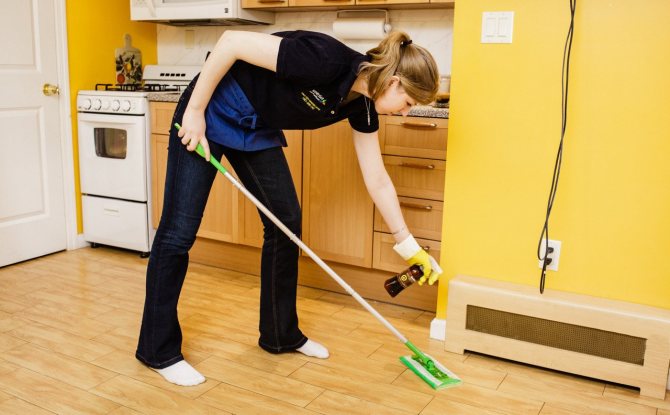

Keep the house clean and insects will not start in it.
Preventive measures
It is important not only to get rid of annoying "neighbors", but also to prevent their re-invasion.
- Ventilate the room more often, avoid dampness and excessive humidity.
- Dry your laundry on the balcony or in a ventilated room, but not in the bathroom. The abundance of wet linen provokes the appearance of not only two-tails, but also mold and mildew.
- Eliminate leaks from pipes, sewers. Trays and jars for collecting water once again attract parasites.
- Thoroughly wring out the rags and dry them on the radiator, do not leave wet towels or rugs on the floor. Wipe puddles dry after a bath.
- Dispose of food waste in a timely manner, keep the kitchen clean, and remove bread crumbs.
- Do not fill potted flowers and change the water in the vases regularly. Excess liquid and rotting organic matter attracts midges, promotes "bloom" and smells unpleasant.
- The two-tailed can get into the house along with vegetables or fruits, for example, in lettuce leaves and in a package with apples. Check the grocery bags after purchase.
- Repair cracks in the walls of the house, floor, baseboards, window frames. Any holes must be covered or treated with polyurethane foam, shrunken structures must be replaced with new ones so that the two-tail does not make its way from the street.
- Dry rooms regularly with space heaters if central heating radiators are not up to the task.
- Remember that a clean, bright room that is kept at a normal level of humidity and regularly ventilated is not interesting for parasites.
How to exterminate a dvuhvostok in a private house
- Reduce lighting at the entrance.
- Close and seal all cracks, crevices, holes in the floor and foundation.
- If possible, eliminate sources of dampness, all plants from the house by about 70-80 cm.
- Check the space under the floor for cleanliness, the presence of damp places, eliminate defects.
- Treat the basement, foundation, hard-to-reach places in the house, outbuildings within a radius of 5 meters with insecticides. The best time to spray chemicals is spring.
- Make sure that there are no animals and people in the house for 3-5 hours.
- Observe preventive measures.
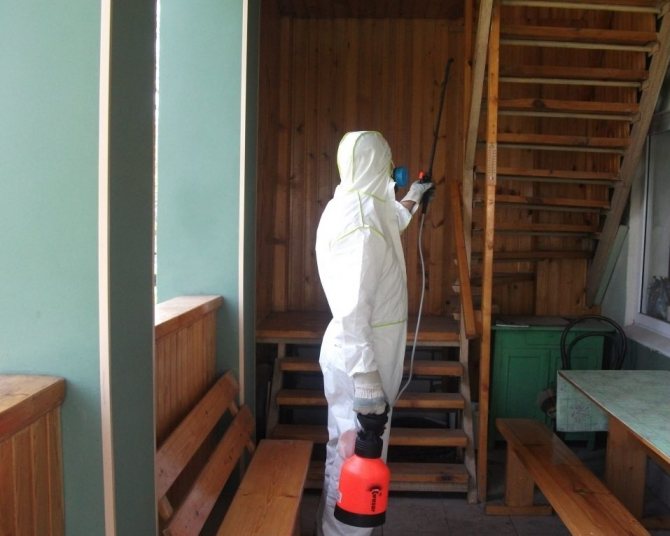

Pest control will help solve the insect problem.
Description of the insect, how dangerous it is
Two-tails do not pose a mortal danger to humans. The only harm is
The affected area is often swollen and itchy. People with allergic reactions may develop Quincke's edema.
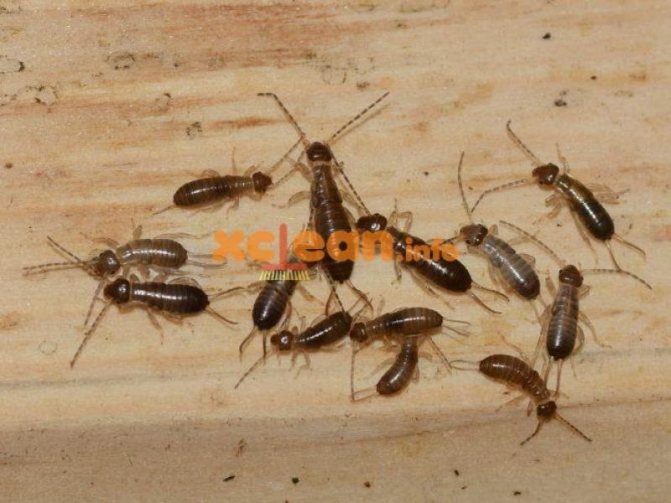

While a person is asleep, the two-tail can invisibly crawl into the ear canal and damage the eardrum by biting through it. Even a lethal outcome is possible. Fortunately, such cases are extremely rare.
Living in dachas or personal plots, the dvukhvostka often harms vegetable crops (eats leaves, sometimes young fruits). At home, indoor plants, such as flowers, suffer.
Dvuhvostki most often show themselves in an area where groundwater is located very close to a plot of land or the foundation of a house, so a person can soon notice them on his doorstep or in a vegetable garden. Also, any swampy area or ordinary high humidity in an apartment for a long time will give an acceptable habitat for this creature.
They can be found in the dampest places - in the bathroom, and even under the old windowsill near the "crying" (collecting condensate) windows. In vegetable gardens, they also settle more in the wettest places. They are nocturnal, so they love to hide in the light. The two-tailed insect is not a poisonous insect, so it is not dangerous when bitten, but it can provoke a number of difficulties and troubles:
- soreness of the bite;
- allergic reactions to the bite;
- high probability of contracting an infection;
- can even get into a person's ear and damage the eardrum;
- spoils cultivated plants in the garden.
However, oddly enough, but such an individual has its own benefits. So, in addition to plants, they also feed on microscopic insects, so they are quite capable of eating all the larvae of bedbugs, or ticks, in your garden.Let them do it there, but don't let them into the house.
First, let's decide whether it is necessary to be afraid of two-tails, whether they bite, whether they can cause any harm to a person.
In general, these insects are harmless and not poisonous. However, they can still cause trouble, because:
- They bite. Not as aggressive as mosquitoes or flies, because they don't do it on purpose. A bite is possible only through accidental contact with a person as a way of self-defense. It is quite painful, and in people prone to allergies, it can cause unpleasant reactions - itching, pain, redness and swelling of the skin.
- They can get into the ear. This also happens very rarely. In addition, you should not believe the tales that this insect with a long tail can gnaw through the membrane and get into the brain. But the sensations are extremely unpleasant, and it is difficult to get him out of there.
- They cause disgust. And some people (especially impressionable women and children) can be driven to hysteria. However, like cockroaches, woodlice, spiders and other arthropods.
- They spoil the harvest. Since they gladly settle in damp beds in the shade of fruit crops.
So decide for yourself whether this small living creature is dangerous for a person, or you are calm about such a neighborhood. If not, now you will find out how to prevent it.
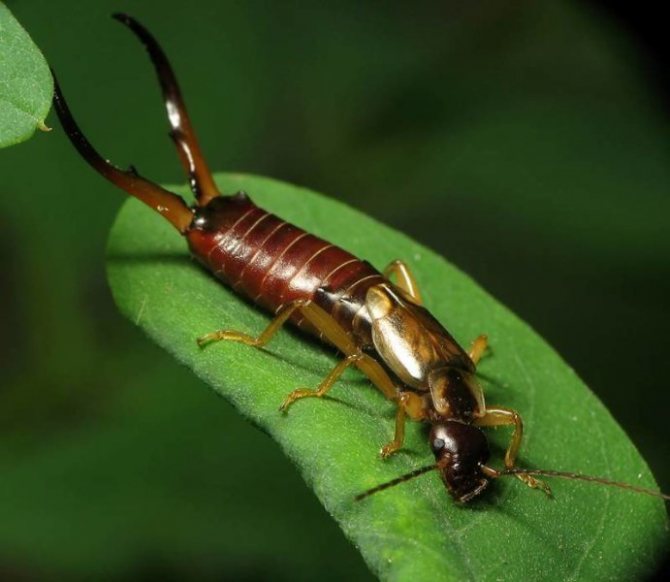

It is worth noting that there are a lot of real horror stories about two-tails. Allegedly, they are able to get into a person's auricle at night and damage the membrane. Many very shy people believe that an insect can get to the brain. As far as realities are concerned, this is not the case.
The fact is that an insect can only bite, and then if there is danger. In other periods of time, the two-tailed does not do any harm to humans. If you are nevertheless bitten by a pest, then you need to treat the damaged area with ointment.
The pest eats:
- other small insects;
- berry;
- fruits;
- vegetables and so on.
It is worth noting that the dvuhvostka most often gets into the room by accident when you bring flowers with the ground. In this regard, do not be frightened, but simply take an insect and carry it out into the street.
It is necessary to get rid of the two-tails immediately, so that in the future there will be no problems. After all, the pest multiplies very quickly, if you start the process, you will have to spend a lot of money and efforts to get rid of it.
How to kick a dvuhvostok from a greenhouse
The two-tails destroy young seedlings, eat the leaves of the shoots, and penetrate the fruits themselves. To combat two-tails in greenhouses and greenhouses, you need to use different methods.
- Dig up the soil in the fall. In this case, the deposited larvae will not hatch, but will freeze.
- Replace all old boards with decay.
- After planting the plants, weed and loosen the soil regularly.
- Plant aromatic herbs with a strong smell (mint, basil)
- Avoid the accumulation of plant debris in and around the greenhouse at any time of the year
- Avoid strong soil moisture, reduce watering as much as possible.
- Ventilate the greenhouse.
- Treat plants with microbiological preparations (Lepidocid, Bitaxibacillin).
- Use available folk remedies.
- If there are a large number of dvuhvostok, it is impossible to remove them with biological products, apply insecticides.
- It is imperative to spray hard-to-reach places of the greenhouse with high-quality preparations after harvesting.
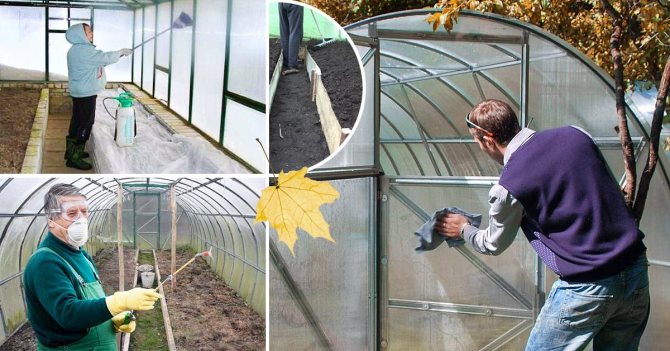

Periodic cleaning of the greenhouse will help solve the insect problem.
Important! If the measures taken have not brought results, you need to call the health service.
Chemical control
If, nevertheless, there is a need to use chemical reagents, then insecticides that contain spinosad, an agent obtained as a result of the activity of bacteria, are most effective against earwigs. This is the most efficient, environmentally friendly product. However, baits containing this substance are often not very effective when there are other food sources more attractive to earwigs.
Spinosad preparations can be applied directly to the soil around susceptible plants before the pests reach them. They also process the foundation of the house. Other, more toxic insecticides are also available, including carbaryl, but these are usually not required if the vigorous activity described above is deployed against earwigs.


And the conclusion is worth emphasizing that indoors, earwigs can be physically destroyed. However, you should not crush them with your hands - the body fluids of the insect contain substances that have a rather foul smell and are poorly washed.
If earwigs are a common problem in a building, you need to inspect your home to see how they get into your home and then seal them tightly. In addition, it is necessary to remove all excess within the outer perimeter of the building, which could provide shelter for insects - ivy on the walls, grass cover, mulch, debris (especially leaves in the gutters), wooden piles and various other rubbish.
In addition, it is necessary to keep water and moisture away by repairing gutters and preventing leaks in water and sewer pipes, as well as ensuring that ventilation is working.
It is not recommended to use insecticides indoors, as they are not very effective, but they are very toxic to humans and pets. Good luck fighting earwigs!
Prevention of the appearance of two-tails
- High quality ventilation.
- Regular airing.
- Timely repair of plumbing.
- Equip all windows with insect screens.
- Reduce humidity at home. In places where condensation accumulates, you can place the most affordable absorbents: cat litter, salt, etc. Exclude drying clothes in the house.
- Cleanliness in the dining area and in the kitchen. Hermetic packaging of products for storage.
- Maintaining cleanliness and order in the room.
- Use of industrial dehumidifiers.
- Timely waste disposal.
- Cleaning of vegetable waste around the perimeter of summer cottages, greenhouses, outbuildings.
- Preventive treatment in the autumn.
- It is better to poison insects in spring, when their activity is high.
- Do not leave compositions made of garden fruits and berries in the public domain.
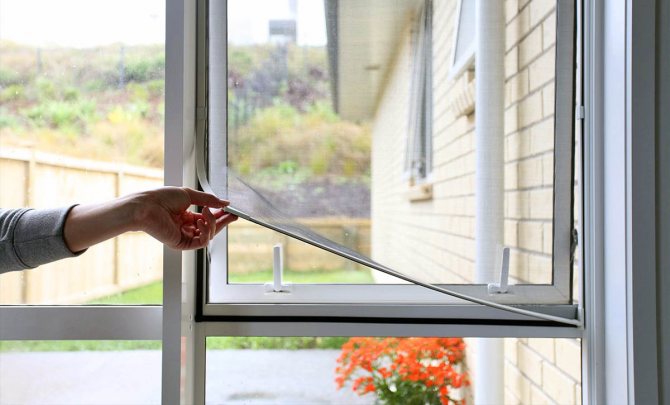

Install mosquito nets on the windows.
Earwigs and two-tails are different insects. They are often confused due to their similar lifestyle and the same tails. Insects multiply quickly, a huge population will occupy the refrigerator in a short time, spoil the harvest, and cause a lot of trouble. To combat two-tails, you need to use a combination of chemical and biological methods.


If you pay special attention to preventive measures, then the risk of insects in the house will be reduced to a minimum.
Folk remedies
Most insects are believed to be repelled by strong odors. Dvuhvostki is no exception. From folk remedies, the following can help
- Onion and garlic tincture. It is not difficult to prepare it: you will need 50 grams each. chopped onions and garlic. The resulting mixture is placed in a jar (0.5 l.), Poured with boiling water and covered with a lid. The liquid should be infused for 24 hours. Then it is filtered, poured into a spray bottle and used to spray the premises. Moreover, all rooms need to be processed (sprayed on the floor and walls): if you miss at least one, then the two-tails will move to a safe place and will multiply there. The amount of working solution directly depends on the volume of the area. 250-300 ml is enough for one room. You need to repeat the procedure once a week, otherwise the two-tails may again choose your home. The only disadvantage of this method is an unpleasant smell, which takes a very long time to disappear.
- Boric acid poison. Take 50 gr. boric acid powder is ground with egg yolk. You should get a pasty consistency, from which small balls are subsequently molded. They are laid out in places where two-tails live.Having eaten such a "treat", the insect will die in a few hours. The disadvantage of this option is that it poses a threat not only to insects, but also to domestic animals (they can accidentally eat the poison). Young children also need supervision: if boric acid enters the esophagus, it causes poisoning
- Damp rags spread across rooms can serve as excellent traps: under them, feeling damp, two-tails slide down. The only task is to destroy the accumulated individuals in time. The safest option is to burn the dvuhvostok. You can also put them in the sink and pour over them with boiling water.
In addition to folk remedies against two-tails, which do little to help, specialized means fight very well with this kind of insects. The formulas of these funds are designed for the harmful effects of various beetles, ticks and other parasites that cause a lot of inconvenience to humans.
Phosbecid
Insecticidal chemical agent against two-tails and a number of other insects. It is dangerous for bees and fish, so make sure that the product does not get into water bodies, not accessible to bees.
- The soil should be sprayed in dry and calm weather.
- Indoors, it is impossible to process this drug - a high degree of toxicity for humans and long weathering, because it has a 2nd hazard class.
- One ampoule is diluted with half a liter of water, and then the solution is filled into the sprayer.
- It is advisable to spray in the morning and evening, 20 days before harvest. Phosbecid today is used by and large as an active substance in the composition of the drug "Actellik".
- The cost of Actellik is 3095 rubles. (1 l), 15475 rubles. (5 l).
Karbofos
"Karbofos" or malathion is a powerful insecticide that has been relevant for quite a long time. It has been used since Soviet times and until now has not lost its relevance.
- The preparation of a dark brown color in a liquid state is produced in vials, most often from glass.
- Very toxic.
- It dissolves poorly in water, and therefore it is better to mix it with organic solvents or soap solutions.
- When processing the interior with Karbofos, it should be remembered that as the temperature rises, its volatility increases, and, accordingly, its toxicity.
- Price - 3150 rubles. (5 l), 30-40 rubles. (30 g of powder).
BUY FOR 1500 rubles
We suggest that you familiarize yourself with Dichlorvos from bedbugs NEO and VARAN: does it help? (reviews)
Tarax
Active con is a chemical preparation of a high hazard and toxicity class for humans, animals, birds, insects.
- When sprayed, the drug creates a kind of film that covers the surface with a continuous “blanket”, upon contact with which insects in the house die.
- Can be used in apartments and houses, with further wet cleaning and room ventilation.
- It is necessary to dilute 1 g of the substance in 200 ml of water, then, this solution is placed in a container with a spray bottle and sprayed in those places where the two-tails are hiding.
- The price of the product in powder weighing 1 g is 80 rubles.
Antizhuk
By and large, it refers to the destruction of those beetles that sharpen a tree in a house or garden. However, it has been noticed that two-tails also perish from it.
- The antiseptic can be used both indoors and outdoors.
- Available in liquid and powder form. The concentrate should be diluted in water at a rate of 0.25 - 0.40 ml / sq. for treating surfaces where earwigs are hiding.
- It is processed using a sprayer, in case of severe insect damage to one or another area, you should repeat the treatment with this drug after two weeks.
- Cost - 280 rubles. (5 l.), 499 rubles. (10 l).
Raptor
- "Raptor" is a universal insecticidal agent in the form of aerosols. With its help, you can protect yourself not only from earwigs, but also from a number of other insects, including blood-sucking ones.
- It acts as a barrier, evaporating, creates a kind of halo, falling under which insects die. This is very convenient if, suddenly, it turned out that the two-tails are hiding between the wall of the cabinet and the wall.
- The application is very simple. Just shake the can slightly and treat for 6-7 seconds the place where the insects were noticed.
- The effect of the drug on earwigs and other beetles is about 8 hours.
- Price - 520-560 rubles. (400 ml).
How to destroy earwigs in the area
It is not for nothing that many owners of summer cottages and private houses are looking for effective methods of how to get rid of the dvuhvostok. Several individuals will not seriously harm the plantings, but in just a few weeks they can occupy the entire area, since one clutch can contain 50 eggs. To clean the area from earwigs:
- Spray plants with Karbofos, Fosbecid or Fufanon. Chemistry can be replaced with an infusion of wormwood and tansy, with the addition of laundry soap (1 kg of plants and 40 g of soap per 10 liters of water).
- Remove old foliage and wood from the site.
- Carry out an autumn deep digging of the soil in order to kill the larvae wintering there.
Folk methods of destroying two-tails
If you do not want to use strong insecticides, you can try more gentle methods, although their effectiveness has not been proven. Lime will help get rid of insects: pieces of calcium oxide are laid out in the corners of the apartment, under cabinets and beds. And with lime milk (2 kg of quicklime per 10 liters of water), they spill the earth around the house in order to scare away and kill pests.
Earwigs do not like pungent odors, so an onion-garlic solution can help drive them out of the apartment: a head of garlic and one onion are cut to a state of gruel and poured with a liter of boiling water. After a day, the mixture is filtered and the floor and baseboards are treated with it, and, if possible, the walls. Spraying is repeated every 7 days.


You can also make traps for two-tails: crumple and spread wet rags and newspapers in secluded places for 3-4 hours. Then, when insects run there, scald them with boiling water and discard.
To get rid of two-tails forever, it is not enough to kill adult insects: you also need to find and destroy their nests. They often settle under floors, exterior cladding of a house, in crevices, insulation and sealants, including polyurethane foam.

